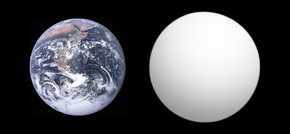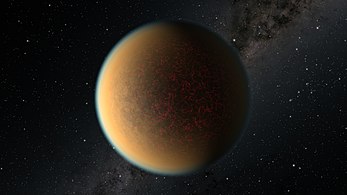| Revision as of 23:22, 28 January 2022 editPraemonitus (talk | contribs)Autopatrolled, Extended confirmed users65,786 editsm rm stub tag← Previous edit |
Revision as of 04:37, 30 January 2022 edit undoCitation bot (talk | contribs)Bots5,445,333 edits Alter: template type. Add: magazine. Removed parameters. Some additions/deletions were parameter name changes. | Use this bot. Report bugs. | Suggested by AManWithNoPlan | #UCB_webform 1149/1776Next edit → |
| Line 24: |
Line 24: |
|
'''Gliese 1132 b''' (also known as '''GJ 1132 b''') is an ] orbiting the ] star ] 40 ] (13 ]s) from ],<ref name="Berta-Thompson2015"/> in the constellation ]. The planet is considered uninhabitable but cool enough to possess an ].<ref name="MIT News">{{cite news |last=Chu |first=Jennifer |url=https://news.mit.edu/2015/new-earth-sized-exoplanet-1111 |title=New exoplanet in our neighborhood |work=MIT News |date=November 11, 2015 |access-date=2015-11-12 }}</ref> Gliese 1132 b was discovered by the ] in Chile.<ref name="Eager">{{cite news |title = Astronomers Eager to Get a Whiff of Newfound Venus-like Planet|work = ]|date = November 11, 2015|access-date = 2015-11-12|url = https://www.cfa.harvard.edu/news/2015-24}}</ref> |
|
'''Gliese 1132 b''' (also known as '''GJ 1132 b''') is an ] orbiting the ] star ] 40 ] (13 ]s) from ],<ref name="Berta-Thompson2015"/> in the constellation ]. The planet is considered uninhabitable but cool enough to possess an ].<ref name="MIT News">{{cite news |last=Chu |first=Jennifer |url=https://news.mit.edu/2015/new-earth-sized-exoplanet-1111 |title=New exoplanet in our neighborhood |work=MIT News |date=November 11, 2015 |access-date=2015-11-12 }}</ref> Gliese 1132 b was discovered by the ] in Chile.<ref name="Eager">{{cite news |title = Astronomers Eager to Get a Whiff of Newfound Venus-like Planet|work = ]|date = November 11, 2015|access-date = 2015-11-12|url = https://www.cfa.harvard.edu/news/2015-24}}</ref> |
|
|
|
|
|
It has been called "one of the most important planets ever discovered beyond the Solar System": Due to its relative proximity to Earth, telescopes should be able to determine the composition of its atmosphere, the speed of its winds and the color of its sunsets.<ref>{{Cite web|title = Earth-like world could be 'most important planet found outside solar system'|url = https://www.theguardian.com/science/2015/nov/11/earth-like-world-gj1132b-could-be-most-important-planet-ever-found-outside-the-solar-system|website = The Guardian|access-date = 2015-11-11|first = Ian|last = Sample}}</ref><ref>{{Cite web|title = Exoplanet GJ 1132b: the 'most important' ever found|url = https://www.wired.co.uk/news/archive/2015-11/12/gj-1132b-most-important-planet-solar-system|website = Wired UK|access-date = 2015-11-12|last = Burgess|first = Matt}}</ref><ref name="Kavli">{{cite news |url=http://www.kavlifoundation.org/science-spotlights/getting-close-and-personal-earth-sized-exoplanet#.VkYmYeSFMY8 |title=Getting Up Close and Personal with an Earth-Sized Exoplanet |work=The Kavli Foundation |date=November 11, 2015 |access-date=2015-11-13 }}</ref> This is due in part to the small diameter of its parent star (20% that of the Sun), which increases the effect on the star's light of its ]s. The planet's diameter is approximately 20% larger than that of the Earth<ref name="Berta-Thompson2015"/> and its mass is estimated at 1.6 times that of Earth,<ref name="MIT News"/> implying that it has an Earth-like ].<ref name=Kowacki /> Gliese 1132 b orbits its star every 1.6 days at a distance of 1.4 million miles (2.24 million kilometres).<ref name='Eager'/> |
|
It has been called "one of the most important planets ever discovered beyond the Solar System": Due to its relative proximity to Earth, telescopes should be able to determine the composition of its atmosphere, the speed of its winds and the color of its sunsets.<ref>{{Cite web|title = Earth-like world could be 'most important planet found outside solar system'|url = https://www.theguardian.com/science/2015/nov/11/earth-like-world-gj1132b-could-be-most-important-planet-ever-found-outside-the-solar-system|website = The Guardian|access-date = 2015-11-11|first = Ian|last = Sample}}</ref><ref>{{Cite magazine|title = Exoplanet GJ 1132b: the 'most important' ever found|url = https://www.wired.co.uk/news/archive/2015-11/12/gj-1132b-most-important-planet-solar-system|magazine = Wired UK|access-date = 2015-11-12|last = Burgess|first = Matt}}</ref><ref name="Kavli">{{cite news |url=http://www.kavlifoundation.org/science-spotlights/getting-close-and-personal-earth-sized-exoplanet#.VkYmYeSFMY8 |title=Getting Up Close and Personal with an Earth-Sized Exoplanet |work=The Kavli Foundation |date=November 11, 2015 |access-date=2015-11-13 }}</ref> This is due in part to the small diameter of its parent star (20% that of the Sun), which increases the effect on the star's light of its ]s. The planet's diameter is approximately 20% larger than that of the Earth<ref name="Berta-Thompson2015"/> and its mass is estimated at 1.6 times that of Earth,<ref name="MIT News"/> implying that it has an Earth-like ].<ref name=Kowacki /> Gliese 1132 b orbits its star every 1.6 days at a distance of 1.4 million miles (2.24 million kilometres).<ref name='Eager'/> |
|
|
|
|
|
The planet receives 19 times more ] than Earth.<ref name="Berta-Thompson2015"/> The temperature of the top of its atmosphere is estimated at {{convert|500|F|C K}}. The planet is estimated to be hotter than Venus, as higher temperatures may prevail near the surface.<ref name=Kowacki>{{cite web| url=http://www.csmonitor.com/Science/2015/1111/Spotted-A-rocky-Earth-sized-planet-close-by| title=Spotted: A rocky Earth-sized planet close by |work=]| date=2015-11-11| author=Eva Botkin-Kowacki}}</ref> ''(cf. ], ])'' It is possible that one side of the planet is cooler, because it is presumed to be ] due to its proximity to its star; however, under most circumstances where an atmosphere is thick, it would be able to transfer heat to the far side. |
|
The planet receives 19 times more ] than Earth.<ref name="Berta-Thompson2015"/> The temperature of the top of its atmosphere is estimated at {{convert|500|F|C K}}. The planet is estimated to be hotter than Venus, as higher temperatures may prevail near the surface.<ref name=Kowacki>{{cite web| url=http://www.csmonitor.com/Science/2015/1111/Spotted-A-rocky-Earth-sized-planet-close-by| title=Spotted: A rocky Earth-sized planet close by |work=]| date=2015-11-11| author=Eva Botkin-Kowacki}}</ref> ''(cf. ], ])'' It is possible that one side of the planet is cooler, because it is presumed to be ] due to its proximity to its star; however, under most circumstances where an atmosphere is thick, it would be able to transfer heat to the far side. |
|
|
|
|
|
==Atmosphere== |
|
==Atmosphere== |
|
In April 2017, a hydrogen-dominated atmosphere was claimed to have been detected around Gliese 1132 b.<ref>{{cite web|url = https://phys.org/news/2017-04-atmosphere-super-earth.html|title = Atmosphere around super-Earth detected|website=Phys.Org|date = April 6, 2017|access-date = April 6, 2017}}</ref><ref name="Southworth2017"/> However, subsequent, more precise work ruled out the claim.<ref name="Diamond-Lowe2018"/> Instead, in 2021 detection of a hazy hydrogen atmosphere without helium but with the admixture ] and ] (implying substantial underlying free ] in the mix, at around 8.9% of the atmosphere) was claimed.<ref>{{cite journal|arxiv=2103.05657|year=2021|title=Detection of an Atmosphere on a Rocky Exoplanet|doi=10.3847/1538-3881/abe879|last1=Swain|first1=Mark R.|last2=Estrela|first2=Raissa|last3=Roudier|first3=Gael M.|last4=Sotin|first4=Christophe|last5=Rimmer|first5=Paul B.|last6=Valio|first6=Adriana|last7=West|first7=Robert|last8=Pearson|first8=Kyle|last9=Huber-Feely|first9=Noah|last10=Zellem|first10=Robert T.|journal=The Astronomical Journal|volume=161|issue=5|page=213|bibcode=2021AJ....161..213S|s2cid=232170188}}</ref> However, two subsequent studies found no evidence for molecular absorption in the HST WFC3 Spectrum of GJ 1132 b. Instead, the spectrum was found to be flat,<ref>{{cite journal|last1=Mugnai|first1=Lorenzo V.|last2=Modirrousta-Galian|first2=Darius|last3=Edwards|first3=Billy|last4=Changeat|first4=Quentin|last5=Bouwman|first5=Jeroen|last6=Morello|first6=Giuseppe|last7=Al-Refaie|first7=Ahmed|last8=Baeyens|first8=Robin|last9=Bieger|first9=Michelle Fabienne|last10=Blain|first10=Doriann|last11=Gressier|first11=Amélie|date=2021-04-05|title=ARES.* V. No Evidence for Molecular Absorption in the HST WFC3 Spectrum of GJ 1132 b|journal=The Astronomical Journal|volume=161|issue=6|page=284|doi=10.3847/1538-3881/abf3c3|arxiv=2104.01873|bibcode=2021AJ....161..284M|s2cid=233025360}}</ref><ref>{{cite arxiv|last1=Libby-Roberts|first1=Jessica E.|last2=Berta-Thompson|first2=Zachory K.|last3=Diamond-Lowe|first3=Hannah|last4=Gully-Santiago|first4=Michael A.|last5=Irwin|first5=Jonathan M.|last6=Kempton|first6=Eliza M.-R.|last7=Rackham|first7=Benjamin V.|last8=Charbonneau|first8=David|last9=Desert|first9=Jean-Michel|last10=Dittmann|first10=Jason A.|last11=Hofmann|first11=Ryan|date=2021-05-21|title=The Featureless HST/WFC3 Transmission Spectrum of the Rocky Exoplanet GJ 1132b: No Evidence For A Cloud-Free Primordial Atmosphere and Constraints on Starspot Contamination|class=astro-ph.EP|eprint=2105.10487}}</ref> which is more consistent with our current understanding of ]. |
|
In April 2017, a hydrogen-dominated atmosphere was claimed to have been detected around Gliese 1132 b.<ref>{{cite web|url = https://phys.org/news/2017-04-atmosphere-super-earth.html|title = Atmosphere around super-Earth detected|website=Phys.Org|date = April 6, 2017|access-date = April 6, 2017}}</ref><ref name="Southworth2017"/> However, subsequent, more precise work ruled out the claim.<ref name="Diamond-Lowe2018"/> Instead, in 2021 detection of a hazy hydrogen atmosphere without helium but with the admixture ] and ] (implying substantial underlying free ] in the mix, at around 8.9% of the atmosphere) was claimed.<ref>{{cite journal|arxiv=2103.05657|year=2021|title=Detection of an Atmosphere on a Rocky Exoplanet|doi=10.3847/1538-3881/abe879|last1=Swain|first1=Mark R.|last2=Estrela|first2=Raissa|last3=Roudier|first3=Gael M.|last4=Sotin|first4=Christophe|last5=Rimmer|first5=Paul B.|last6=Valio|first6=Adriana|last7=West|first7=Robert|last8=Pearson|first8=Kyle|last9=Huber-Feely|first9=Noah|last10=Zellem|first10=Robert T.|journal=The Astronomical Journal|volume=161|issue=5|page=213|bibcode=2021AJ....161..213S|s2cid=232170188}}</ref> However, two subsequent studies found no evidence for molecular absorption in the HST WFC3 Spectrum of GJ 1132 b. Instead, the spectrum was found to be flat,<ref>{{cite journal|last1=Mugnai|first1=Lorenzo V.|last2=Modirrousta-Galian|first2=Darius|last3=Edwards|first3=Billy|last4=Changeat|first4=Quentin|last5=Bouwman|first5=Jeroen|last6=Morello|first6=Giuseppe|last7=Al-Refaie|first7=Ahmed|last8=Baeyens|first8=Robin|last9=Bieger|first9=Michelle Fabienne|last10=Blain|first10=Doriann|last11=Gressier|first11=Amélie|date=2021-04-05|title=ARES.* V. No Evidence for Molecular Absorption in the HST WFC3 Spectrum of GJ 1132 b|journal=The Astronomical Journal|volume=161|issue=6|page=284|doi=10.3847/1538-3881/abf3c3|arxiv=2104.01873|bibcode=2021AJ....161..284M|s2cid=233025360}}</ref><ref>{{cite arXiv|last1=Libby-Roberts|first1=Jessica E.|last2=Berta-Thompson|first2=Zachory K.|last3=Diamond-Lowe|first3=Hannah|last4=Gully-Santiago|first4=Michael A.|last5=Irwin|first5=Jonathan M.|last6=Kempton|first6=Eliza M.-R.|last7=Rackham|first7=Benjamin V.|last8=Charbonneau|first8=David|last9=Desert|first9=Jean-Michel|last10=Dittmann|first10=Jason A.|last11=Hofmann|first11=Ryan|date=2021-05-21|title=The Featureless HST/WFC3 Transmission Spectrum of the Rocky Exoplanet GJ 1132b: No Evidence For A Cloud-Free Primordial Atmosphere and Constraints on Starspot Contamination|class=astro-ph.EP|eprint=2105.10487}}</ref> which is more consistent with our current understanding of ]. |
|
|
|
|
|
==Gallery== |
|
==Gallery== |
It has been called "one of the most important planets ever discovered beyond the Solar System": Due to its relative proximity to Earth, telescopes should be able to determine the composition of its atmosphere, the speed of its winds and the color of its sunsets. This is due in part to the small diameter of its parent star (20% that of the Sun), which increases the effect on the star's light of its transits. The planet's diameter is approximately 20% larger than that of the Earth and its mass is estimated at 1.6 times that of Earth, implying that it has an Earth-like rocky composition. Gliese 1132 b orbits its star every 1.6 days at a distance of 1.4 million miles (2.24 million kilometres).
In April 2017, a hydrogen-dominated atmosphere was claimed to have been detected around Gliese 1132 b. However, subsequent, more precise work ruled out the claim. Instead, in 2021 detection of a hazy hydrogen atmosphere without helium but with the admixture methane and hydrogen cyanide (implying substantial underlying free nitrogen in the mix, at around 8.9% of the atmosphere) was claimed. However, two subsequent studies found no evidence for molecular absorption in the HST WFC3 Spectrum of GJ 1132 b. Instead, the spectrum was found to be flat, which is more consistent with our current understanding of photoevaporation.
 Size comparison of GJ 1132 b with Earth.
Size comparison of GJ 1132 b with Earth. An artist's impression of the exoplanet GJ 1132 b.
An artist's impression of the exoplanet GJ 1132 b.


